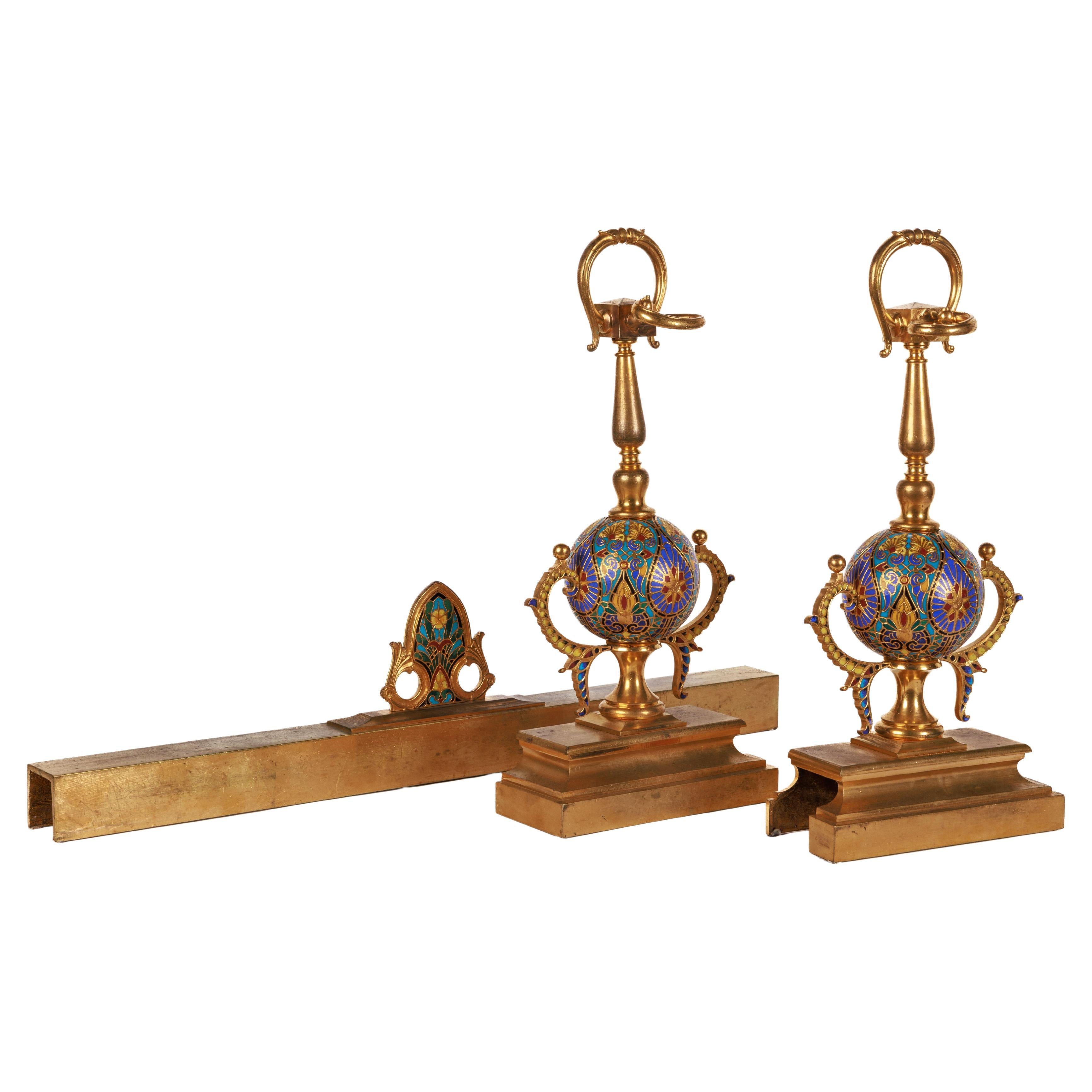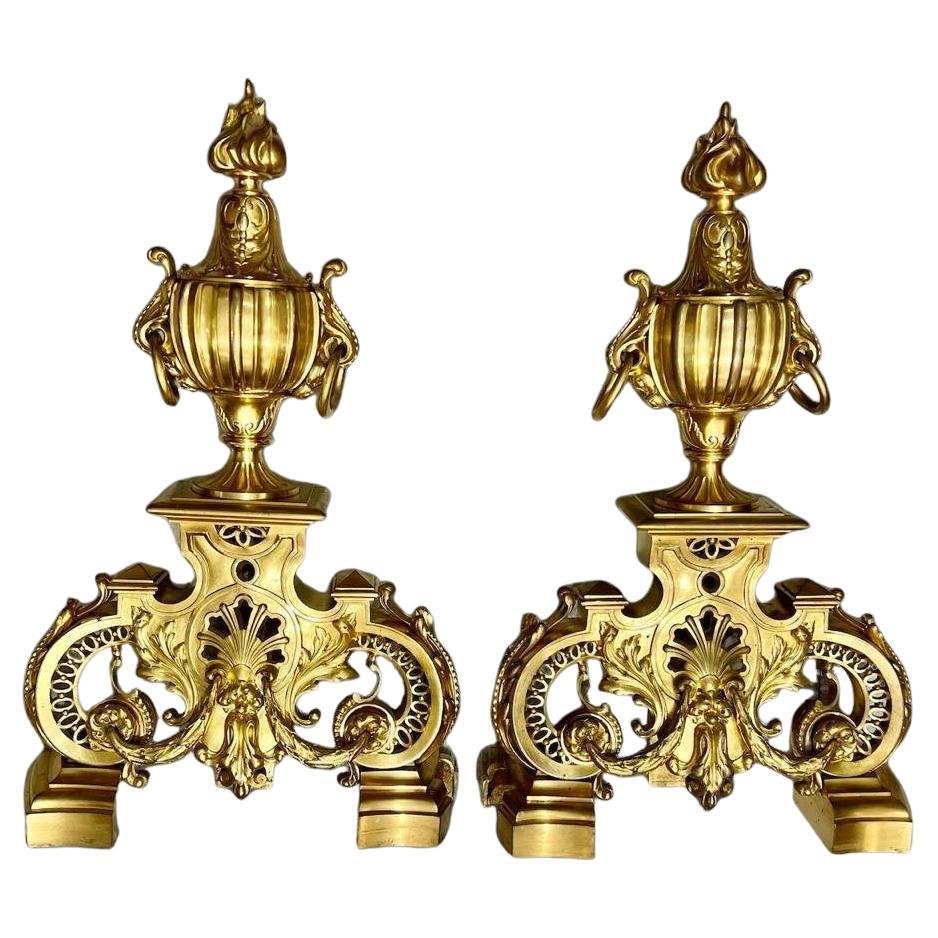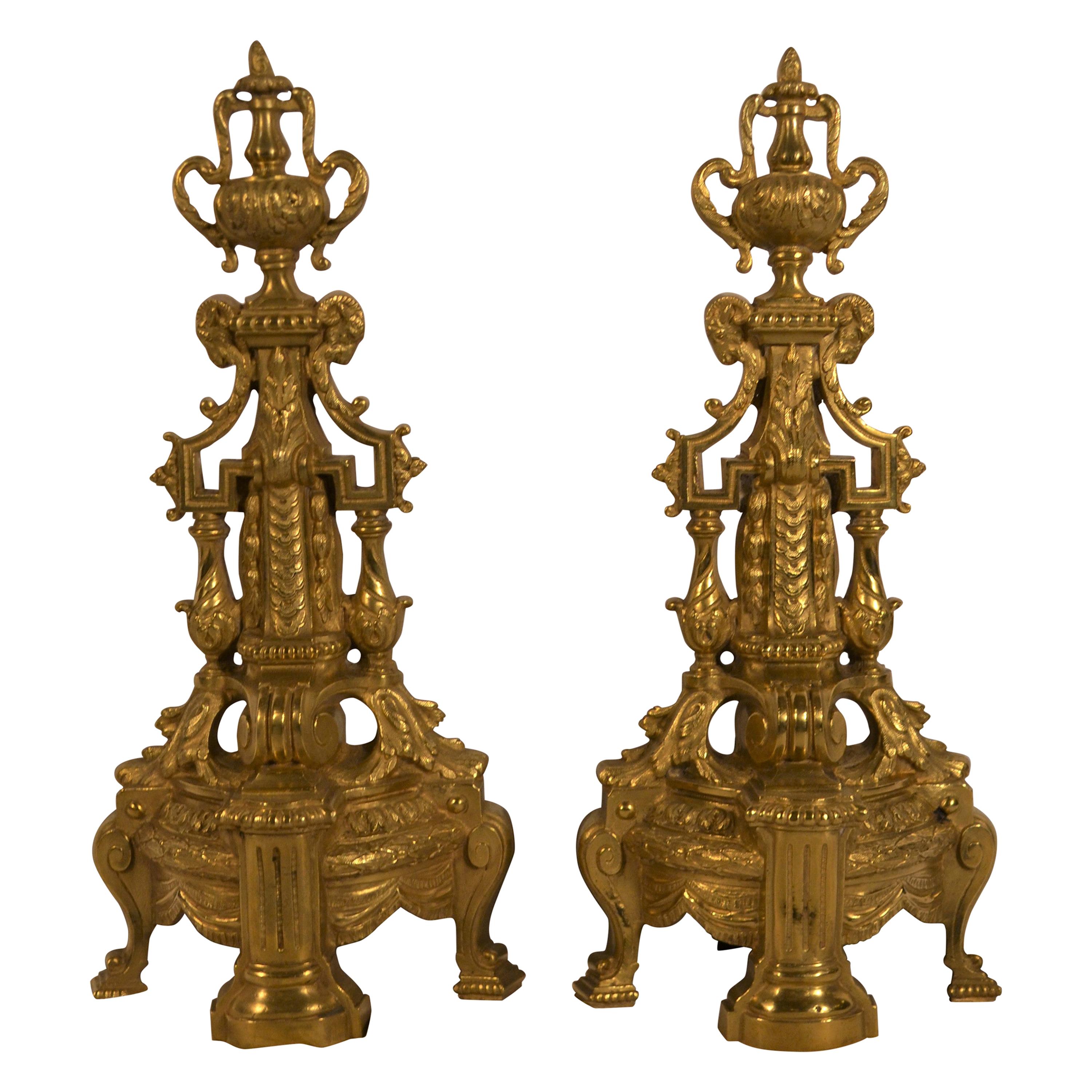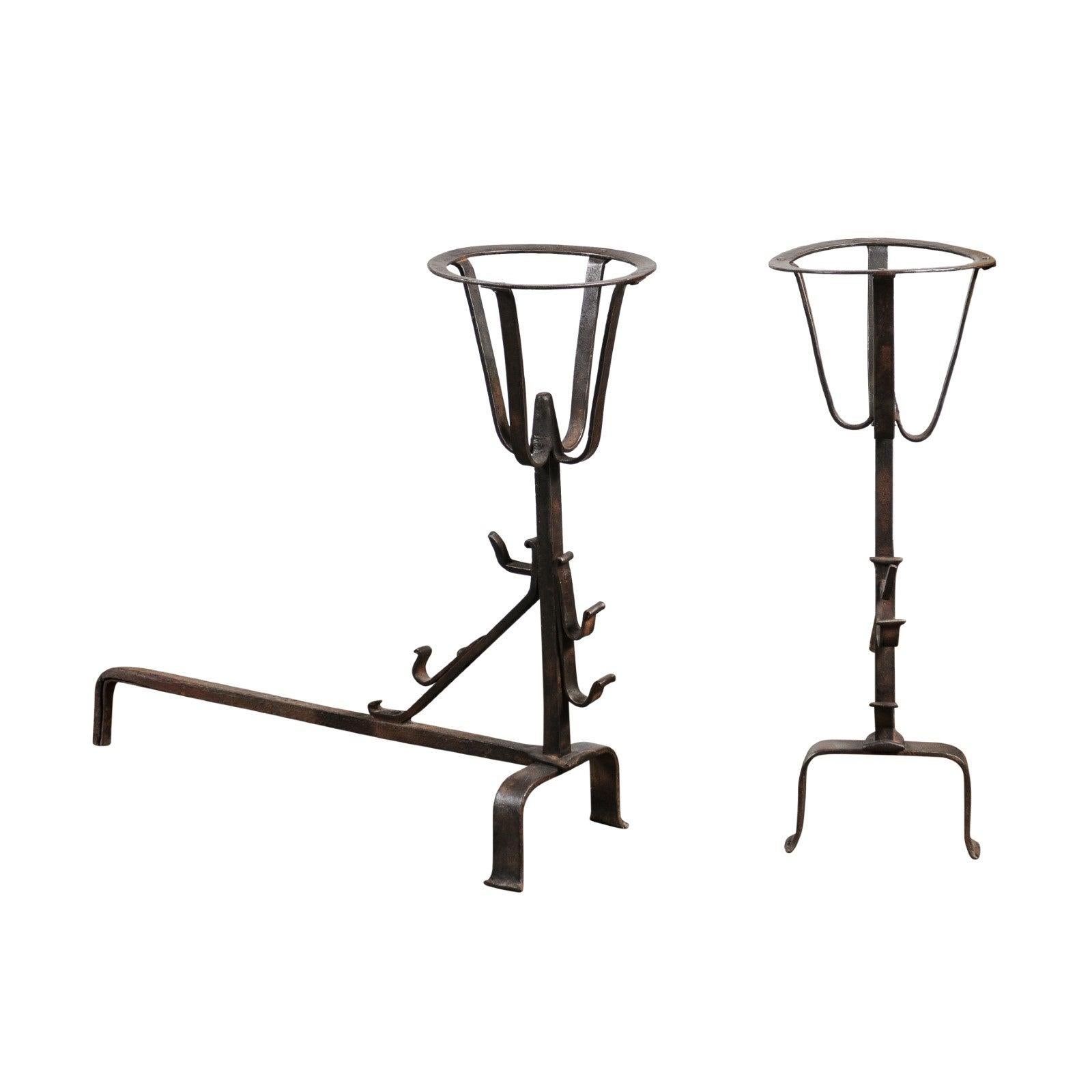Items Similar to Pair of Neo-Greek Andirons by F. Barbedienne, France, Circa 1870
Want more images or videos?
Request additional images or videos from the seller
1 of 6
Pair of Neo-Greek Andirons by F. Barbedienne, France, Circa 1870
About the Item
Measures: Height : 47 cm (18,5 in.) ; Width : 70 up to 96 cm (27,5 – 37,8 in.) ; Depth : 6 cm (2,3 in.)
A rare pair of square shaped andirons, made in gilded bronze and polychrome « champlevé » enamel. Designed in the Greek style with characteristic motifs such panther head terminating in paw, adorned with palmets, rosettes and « entrelacs ». Decorated with very fine « champlevé » enamels of remarkable quality made with further palmets, scales and pine cones.
Born in 1810, Ferdinand Barbedienne started at n°30 boulevard Poissonnière in Paris one of the most famous 19th century artistic bronze casting companies. He died in 1892. In addition to his personal production, he worked for famous artists such as Auguste Clésinger (1814-1883), Albert-Ernest Carrier-Belleuse (1824-1887) and Louis Barrias (1841-1905 At the London Universal Exhibition of 1862 Barbedienne exhibited some « cloisonné » enamel works, which were for most of them designed by Constant Sévin (1821-1888), and won medals in three different categories : Furniture, Silversmith work and Artistic bronzes, combining for some pieces with enamels (Oriental style cup, Château de Compiègne, Inv. C 71-122). Barbedienne’s production was always highly esteemed and he was, himself admired by contemporary art critics who compared him during the 1878 Universal Exhibition to a « prince of industry and the king of bronze-casting ».
- Creator:Ferdinand Barbedienne (Manufacturer)
- Dimensions:Height: 18.51 in (47 cm)Width: 27.56 in (70 cm)Depth: 2.37 in (6 cm)
- Sold As:Set of 2
- Style:Greek Revival (In the Style Of)
- Materials and Techniques:
- Place of Origin:
- Period:
- Date of Manufacture:circa 1870
- Condition:Wear consistent with age and use.
- Seller Location:PARIS, FR
- Reference Number:
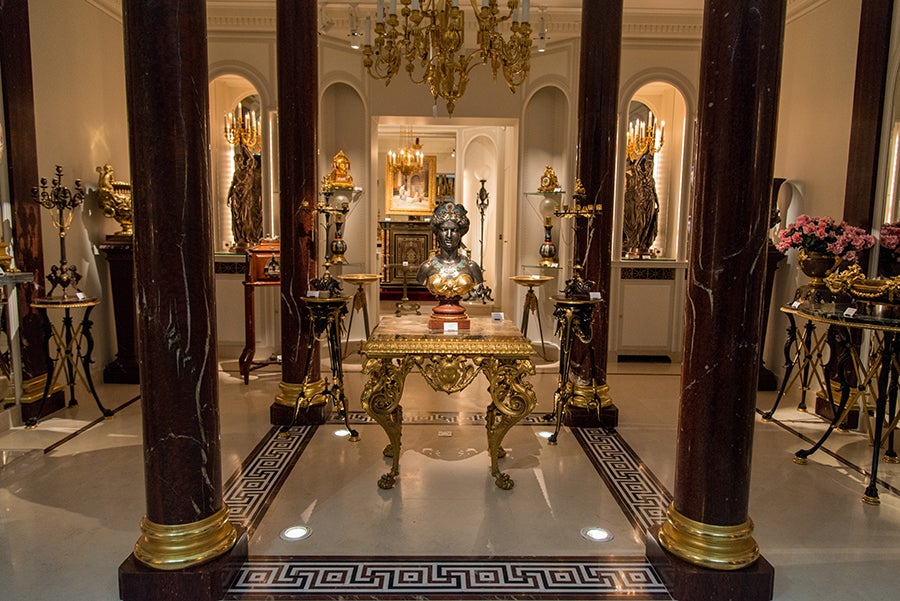
About the Seller
4.9
Vetted Seller
These experienced sellers undergo a comprehensive evaluation by our team of in-house experts.
Established in 1997
1stDibs seller since 2018
73 sales on 1stDibs
Typical response time: <1 hour
Associations
International Confederation of Art and Antique Dealers' Associations
- ShippingRetrieving quote...Ships From: PARIS, France
- Return PolicyA return for this item may be initiated within 7 days of delivery.
More From This SellerView All
- Pair of Neo-Greek Bronze Floor Lamps by F. Barbedienne, France, circa 1860By Ferdinand BarbedienneLocated in PARIS, FRHeight without/with lampshade : 168/185 cm (66,1 / 72,8 in.) ; Base : 43 x 43 cm (16,9 x 16,9 in.) Beautiful pair of neo-Greek floor lamps in bronze with double patina, composed of cylindrical lamps, decorated on the body with a rotating frieze representing women dressed in the Antique style weaving and spinning, surmounted by lampshades with cut sides in red pleated silk with golden braid. They are placed on pedestals from which hang thin chains attached to the slender shaft decorated with stylized leaves and flowers, resting on a tripod base decorated with large palmettes and ending in lion’s paws. The stylistic repertoire used here, composed in particular of palmettes, masks, and nymphs, evokes Greek Antiquity, as does the reuse of forms of furniture and objects such as tripods and antique vases. The rediscovery in the 18th century of the archaeological remains of Pompeii and Herculaneum allowed artists of all disciplines to draw inspiration from Antiquity while reinterpreting it. This trend did not fade and, in the 19th century, many personalities fitted out their interiors with neo-Greek furniture, as was the case for the Maison Pompéienne built in 1856 by the architect Alfred Normand (1822-1909) for Prince Napoleon, or Empress Eugénie who bought from the Maison Barbedienne pedestals inspired by antique tripods. Related work : Pedestal model presented by Maison Barbedienne at the Universal Exhibition in Paris in 1855. On this occasion, Empress Eugénie bought it for her bathroom in the Château de Saint-Cloud. This model pleased the Empress so much that she ordered two other pairs in 1858 for her boudoir in the palaces of Compiègne and Fontainebleau. (see photo attached) Photo showing a floor lamp similar to ours in Empress Eugénie’s bedroom in the Château de Compiègne (Oise), in Architecture intérieure et Décoration en France des...Category
Antique 1860s French Greek Revival Floor Lamps
MaterialsBronze
- Pair of Neo-Greek Amphora Vases by Barbedienne and Levillain, France, circa 1880By Ferdinand Levillain, Ferdinand BarbedienneLocated in PARIS, FRPair of Greek style vases made two patina bronze. Each, designed in the shape of a tripod amphora adorned with Hercules heads, is decorated in low-relief...Category
Antique 1880s French Greek Revival Vases
MaterialsGriotte Marble, Bronze
- Pair of Neo-Greek Wall-Lights Attributed to F. Barbedienne, France, Circa 1880By Ferdinand BarbedienneLocated in PARIS, FRA pair of neo-Greek wall-light sconces executed in two patina bronze attributed to F. Barbedienne. The central up-turned foliage stem, surmounted by a Greek style vase...Category
Antique 1880s French Greek Revival Wall Lights and Sconces
MaterialsBronze
- Large Neo-Greek Vase by F. Levillain & F. Barbedienne, France, circa 1890By Ferdinand Barbedienne, Ferdinand LevillainLocated in PARIS, FRImportant neo-Greek vase in the shape of an Amphora, made in two patina bronze. The body is decorated with a rich continuous frieze in bas-relief presenting a procession of characters carrying their offerings to the temple, underlined by a decoration of theatrical masks among olive trees. The 's'-scroll handles decorated with grape vines, resting only on the shoulder of the vase, are supported by a ram’s head. Numerous palmettes and friezes adorn the whole. Resting on a molded marble circular base. Biography Ferdinand Levillain (Paris, 1837-1905) studied under the sculptor Jouffroy (1806-1882), before making his debut in 1861 at the French Artists Salon where he continued to exhibit until 1903. At the 1867 Universal Exhibition in Paris, he was praised for a Neo-Greek style bronze cup he made for the firm Blot and Drouard. He was not to become really famous, however, until 1871 thanks to his association with the great bronze founder Ferdinand Barbedienne, who began to exhibit Neo-Greek style lamps...Category
Antique 1890s French Greek Revival Vases
MaterialsMarble, Bronze
- Neo-Greek Gueridon Attributed to F. Barbedienne, France, Circa 1880By Ferdinand Barbedienne, Louis-Constant SevinLocated in PARIS, FRA similar model was exposed at the 1889 Paris Universal Exhibition ( see picture attached) Patinated and gilded bronze gueridon with four paw feet joined by X-shaped stems, attributed to Sévin and Barbedienne. Round green marble top mounted with a bronze rim adorned with oves and pearls motif. Born in 1821 and dead in Paris in 1888, Louis-Constant Sévin was apprenticed to the parisian sculptor Marneuf. In 1839, he joined the sculptor-modelors Phénix and Joyau, as designer, and designed silver-smith’s objects for famous firms like Denière, Froment-Meurice, Morel and Duponchel. During the Revolution in 1848, C. Sévin joined Morel in London, as workshop manager and designed pieces that Morel exhibited in 1851. Back in France in 1851, C. Sévin went to Limoges and designed models for the porcelain factories of Jouhanneaud and Dubois of which many pieces were exhibited at the Universal Exhibition in 1855. From this date on, he worked for Ferdinand Barbedienne as sculptor-ornemanist until the end of his life. Sévin’s works are considerable, he designed furniture bronzes for the « hôtel de La Païva ». At the London Exhibition in 1862, he was awarded a medal « pour l’excellence artistique des meubles qu’il a dessinés et qui sont exposés par Barbedienne » : for the artistic excellence of the furniture he designed and which is exhibited by F. Barbedienne. He won a second class medal at the Union centrale des Arts décoratifs Exhibition in 1863 and was awarded a gold medal as « cooperator ». F. Barbedienne said that posterity would remember Sévin’s compositions. The most extraordinary object designed by C. Sévin for F. Barbedienne, was a Renaissance style gilded bronze monumental clock...Category
Antique 1880s French Greek Revival Center Tables
MaterialsMarble, Bronze
- Fine Pair of Neo-Greek Vases by F. Levillain and F. Barbedienne, France, c. 1890By Ferdinand Levillain, Ferdinand BarbedienneLocated in PARIS, FRSigned F. Levillain sculpteur and F. Barbedienne. Pair of Greek style vases made of two patina bronze. Each, designed in the shape of a amphora resting on four hoof feet and a quadrilobed base, is decorated in low-relief with ancient times scenes of grape harvest and picking hops. Overleaf vases, profiles of gods Ariadne and Bacchus are ornated with grape vines and cornucopias. The handles are supported by two bearded heads of gods. Here is the model titled Amphore vendangeurs, modèle n°1 (68 cm), edited by Barbedienne after 1891. We find it in the catalogs until 1911. The figure of Bacchus is a subject dear to Ferdinand Levillain, which he exhibited bronze medallions in his first exposition as well as Universal Exhibitions in which he participated. Ferdinand Levillain (Paris, 1837-1905) studied under the sculptor Jouffroy (1806-1882), before making his debut in 1861 at the French Artists Salon where he continued to exhibit until 1903. At the 1867 Universal Exhibition in Paris, he was praised for a Neo-Greek style bronze cup he made for the firm Blot and Drouard. He was not to become really famous, however, until 1871 thanks to his association with the great bronze founder Ferdinand Barbedienne, who began to exhibit Neo-Greek style lamps...Category
Antique 1890s French Greek Revival Vases
MaterialsBronze
You May Also Like
- Ferdinand Barbedienne, A Pair of French Ormolu and Champleve Enamel AndironsBy Ferdinand BarbedienneLocated in New York, NYFerdinand Barbedienne, A Pair of French Ormolu and Champleve Enamel Andirons, Chenets, circa 1870. A rare and unusual pair of bronze and multi-colored champleve enameled andirons / ...Category
Antique 19th Century French Napoleon III Fireplace Tools and Chimney Pots
MaterialsBronze, Enamel, Ormolu
- 19th Century Andirons in Gilt Bronze, Signed by Ferdinand BarbedienneBy Ferdinand BarbedienneLocated in NICE, FRWe present you with this beautiful pair of large andirons with their gilded bronze bar. They exemplify the exuberant Napoleon III style and they originate from the late 19th century....Category
Antique 19th Century French Napoleon III Fireplace Tools and Chimney Pots
MaterialsBronze
- Pair of Antique French Bronze Andirons, circa 1880Located in New Orleans, LAPair of antique French bronze Andirons, circa 1880.Category
Antique Late 19th Century French Fireplace Tools and Chimney Pots
MaterialsBronze
- Pair of Neoclassical Bronze Andirons, French, circa 1940Located in Marcq-en-Barœul, Hauts-de-FranceThis pair of andirons in the neoclassical style are made of brass and wrought Iron. They are French, circa 1940.Category
Vintage 1940s French Neoclassical Fireplace Tools and Chimney Pots
MaterialsBronze, Iron
- Pair of French 1870s Napoléon III Period Andirons with Circular TopsLocated in Atlanta, GAA pair of French Napoléon III period andirons from the late 19th century. Created in France at the end of Emperor Napoléon III's reign to hold flaming firewood slightly above the fir...Category
Antique 19th Century French Fireplace Tools and Chimney Pots
MaterialsIron
- Pair of Neo-Classic Homer and Virgil AndironsLocated in New York, NYPair of Italian Neo-classic-style (19th Century) bronze andirons of busts of Homer and Virgil on etched pedestal bases (PRICED AS Pair)Category
Antique 19th Century Italian Fireplace Tools and Chimney Pots
MaterialsBronze
